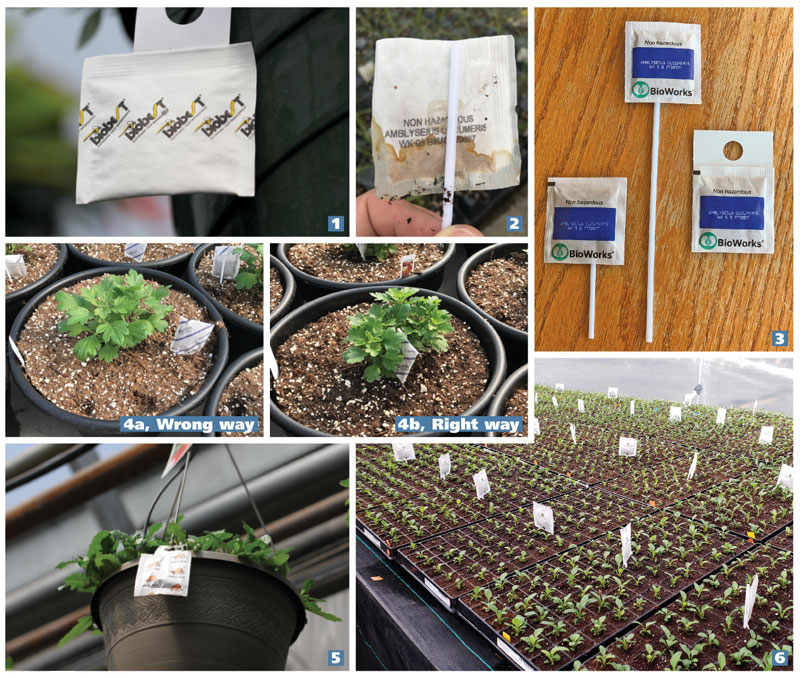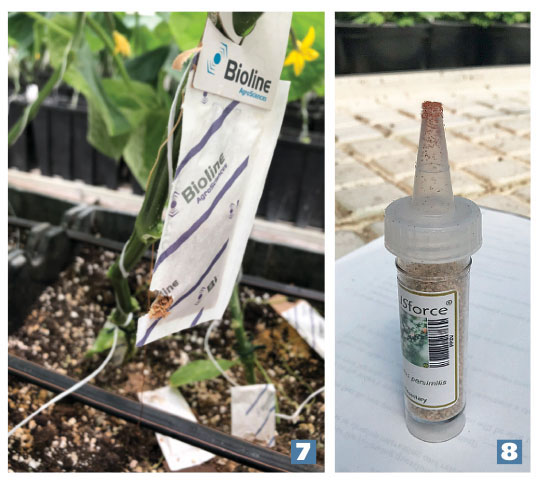3/1/2021
Release the Beasts
John Sanderson, Suzanne Wainwright-Evans & Ronald Valentin
Predatory mites such as Neoseiulus cucumeris, N. californicus, Amblyseius swirskii, A. andersoni and Phytoseiulus persimilis are among the most common biological control agents (BCAs) used for biocontrol on greenhouse crops. N. cucumeris and A. swirskii are most commonly used against Western flower thrips (WFT), though they will also attack broad mites; A. swirskii also attacks whitefly eggs and young nymphs; A. andersoni and
N. californicus attack various mite pests, including spider mites and broad mites; and P. persimilis is a voracious predator of twospotted spider mites. Successful cost-effective biocontrol with these mites will significantly depend on using proper introduction techniques.
There are some important things about the mites to keep in mind when considering how best to release them into your crop. First, they’re tiny, much smaller than an adult thrips for example. Second, they cannot fly and must walk to disperse or hunt, so their ability to traverse “short” distances between plants or over a soil surface might be much more of a challenge to them than you’d assume. At their size, crawling across an inch of growing mix or a hairy leaf surface might be like a human making their way through a dense jungle.
Third, they’re essentially blind with no ability to see their prey. Fourth, most of their foraging is done by random searching, though sensing prey chemicals can play a part. They don’t hunt by seeing their prey from a distance and running directly toward it; it’s more like they bump into their prey during their random searching. Taking these factors together might help you think of how to make it as easy as possible for these mites to find their prey and do their best work for you.
N. cucumeris/A. swirskii/A. andersoni/N. californicus predatory mites
These mites can be applied in “slow-release” sachets or broadcast over the crop. Sachets create a rearing system that can provide a continuous release of predatory mites for weeks under optimum conditions. The sachets are usually made of special paper that maintain humidity and are somewhat water-resistant.
Ulti-Mite sachets by Koppert Biological Systems use a compostable foil-like material that’s claimed to provide better humidity control and are more water-resistant. Sachets contain bran with a non-pest “food mite” for the predatory mites in the sachet. The food mites feed on yeast/fungus that grows on the bran, and the predators feed and reproduce on the food mites. A small hole in the sachet (Figure 1) allows the predators to disperse into the plant canopy. The hole may look like it’s not fully open, but it’s been carefully researched to allow the best mite dispersal while preventing water from entering or leaving the sachet. Do not open the hole any further or the moisture balance will be affected. This hole also reduces the chances of other predators, such as rove beetles (Dalotia coriaria), from entering the sachet.
The water-resistant paper of the sachets is okay to get wet under normal greenhouse irrigation or mist systems, but not soaked. Sachets shouldn’t be in contact with the soil or the paper can become soaked. This excessive soaking will destroy the rearing system inside the sachet (Figure 2).
Sachets come with hangers or sticks/stakes. Hangers have paper hooks that allow sachets to be hung within the crop canopy. Stakes/sticks support the sachet just above the soil surface in pots or trays. Care must be taken to insert the stake into the soil such that the sachet is kept above the soil surface and not allowed to stay in constant soil contact to avoid becoming water-soaked. Recently some companies are providing sachets with long sticks. The stick is so long that it hits the bottom of a hanging basket and the sachet still sits above the soil level (Figure 3).
Unless you’re starting a crop with broadcast applications (see below), sachets should be applied to the crop at planting or as soon thereafter as possible, especially for A. swirskii and N. cucumeris against WFT. Usually one to two sachets per tray, or one per pot or basket are used, targeting the most WFT-susceptible crops/cultivars, such as argyranthemum, bidens, chrysanthemum, dahlia, dracaena, ivy geranium, impatiens, New Guinea impatiens, calibrachoa, ipomoea, rudbeckia, thunbergia, verbena, mixed containers (especially if they contain calibrachoa, ipomoea and/or verbena), and other crops that you find are very WFT-susceptible. It’s important to protect WFT-susceptible crops with a sachet. A. swirskii and N. cucumeris used for WFT control are also being used for broad mite control. Prevention is critical with this pest, so sachets are being used heavily early in crops like New Guinea impatiens.
Sachets should be shaded as much as possible, especially when it’s hot and sunny. Sachets should always be placed such that they’re physically touching plants. The predators are much less likely to end up on the plant if they must crawl over the soil substrate from sachet to the foliage (Figures 4A and 4B). It’s also best to keep sachets shaded if possible, tucked into the canopy. Sachets that are hanging from the outside rim of a basket, but not in contact with the foliage, may make it less likely that all the predators will make it onto the foliage to attack pests (Figure 5). Sachets with hangers can eventually be hung in the canopies of longer-term crops with taller canopies.
Research by Dr. Rose Buitenhuis from the Vineland Research and Innovation Centre has shown that the ability of mites to disperse from a sachet to all the young plants in a tray is greatly dependent on whether the plant canopy is touching. When the canopy hasn’t yet grown together in a tray, the natural bridge that the canopy would provide for mite dispersal from plant to plant is lacking (Figure 6). Some growers apply the mites by broadcasting them weekly or biweekly until the canopy fills in. Sachets are used at the start or once broadcasting ceases.
On occasion, sachets may be damaged by ants, cockroaches or mice that seek the bran (Figure 7), so keep mice and other pests under control to avoid such damage.
The other way that these mites can be released is by broadcasting them over the crop canopy. For broadcasting, the predators are mixed into some sort of carrier, such as vermiculite or sawdust. Blowers for broadcasting can be homemade from battery-powered leaf blowers with a ball valve (plans are available on the Internet) or purchased.
Broadcasting should be done on average every one or two weeks to ensure that sufficient numbers of predators continue to protect the crop. Pollen or other supplemental food products can also be purchased and applied to the canopy to provide additional food for the predators. You can check how well the mites survive the broadcasting by placing sheets of paper horizontally on the canopy and checking for surviving mites with a hand lens after a broadcast application. But research on vegetable crops such as sweet peppers has shown that sachets can provide consistent and higher numbers of these predators than broadcasting.
P. persimilis spider mite predatory mites
P. persimilis can only survive by eating web-spinning spider mites such as twospotted spider mite. Because they’re dependent on spider mites as food for survival, until very recently, they couldn’t be applied in sachets. Recently, BioBee Biological Systems has developed a factitious food that P. persimilis can use as food, so application via sachet may be possible. But, most commonly, adult predators are mixed into sawdust or vermiculite for sprinkling or broadcasting onto crop foliage.
The mites could fall through the foliage of some plants if broadcast. For a crop with a sparse canopy, such as dracaena spikes, a simple way to avoid this problem is to place open sheets of newspaper on top of the canopy in numerous places, sprinkle a small pile of product on the newspaper, leave it overnight, then collect the newspaper the next day. The mites will crawl off the paper and onto the foliage.
To avoid adding a residue from the carrier to the foliage, nipple-topped applicators have become available called “hot spots” (Figure 8). The adult P. persimilis in a bottle are naturally prone to climb upward, so if a bottle of 2,000 predators is fitted with a nipple top and held upright, when the cap is removed from the nipple, very quickly dozens of predators will appear at the tip. Then by simply quickly touching a leaf with the tip of the nipple, a dozen or more predators will instantly walk onto the foliage. This is an excellent way to release P. persimilis onto spider mite hot spots or crops that cannot have a carrier residue.
Lastly, growers producing outdoor crops are beginning to broadcast P. persimilis and other mite and insect predators via drone (Figure 9). This may be the future of beneficial applications, but for now growers will continue to use the tried-and-true methods of broadcasting and sachets. GT

 Figure 1. Sachets have small holes from which the predators can disperse. Do not try to open these holes or remove the punched paper—they’re designed to allow the predators to leave the sachet and maintain proper moisture levels while keeping extra water and other predators out of the sachet. Photo: Suzanne Wainwright-Evans.
Figure 1. Sachets have small holes from which the predators can disperse. Do not try to open these holes or remove the punched paper—they’re designed to allow the predators to leave the sachet and maintain proper moisture levels while keeping extra water and other predators out of the sachet. Photo: Suzanne Wainwright-Evans.
• Figure 2. Position sachets so that they don’t become water-soaked. This will destroy the proper environment for predator reproduction inside the sachet. Photo: Ronald Valentin.
• Figure 3. Sachets on sticks are available to position the sachet just above the soil surface, keeping them from becoming water-soaked and invaded by soil-dwelling predators. Long sticks hit the bottom of a hanging basket to keep the sachet sitting above the soil level. Photo: Ronald Valentin.
• Figures 4A & 4B. Sachets should touch the plant canopy to make it easier for the mites to get to their prey in the plant and to provide shade for the sachet. Placing the sachet away from the foliage, even by an inch or two, will reduce the number of predators that make it to the plant. Photos: John Sanderson.
• Figure 5. Hanging a sachet on the outside rim of a basket, but not in contact with the foliage, may reduce the number of predators that make it onto the foliage to attack pests. Photo: Suzanne Wainwright-Evans.
• Figure 6. The ability of mites to disperse from a sachet to all the seedlings in a tray is greatly dependent on whether the plant canopy is touching. Some growers apply the mites by broadcasting them weekly or biweekly until the canopy fills in. Sachets are used at the start or once broadcasting ceases. Photo: Suzanne Wainwright-Evans.
• Figure 7. Mouse damage to a sachet. Keep pests such as ants, cockroaches and mice under control to prevent damage to the sachets. Photo: Ronald Valentin.
• Figure 8. “Hot spot” applicator for Phytoseiulus persimilis allows release of the predators into spider mite hot spots without adding any carrier to the foliage. Photo: John Sanderson.
John Sanderson is an Associate Professor at Cornell University in Ithaca, New York, and has worked on research and extension for greenhouse pest management for over 30 years. Suzanne Wainwright-Evans is the owner of Buglady Consulting, now in business 20 years. She specializes in biological control agents and troubleshooting pest issues in ornamentals, cannabis and other specialty crops. Ronald Valentin is Technical Director BCA for BioWorks, Inc. and has been active in Biological Control for over 30 years in Europe, Canada and the U.S.